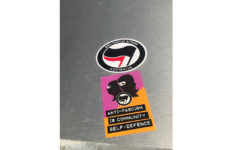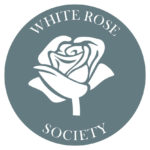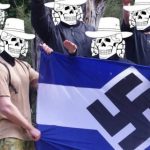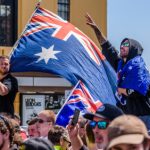Communities of Resistance: An Interview With an Antifascist Activist

The 2005 Cronulla Riots involved five thousand Anglo Australians converging upon North Cronulla Beach to “reclaim” the strip of sand. And the “Aussie pride” protesters began randomly attacking people of Middle Eastern appearance, who were supposedly trying to “take over”.
By the time Party of Freedom held a ten year anniversary barbeque at the site of the riots, organised white nationalist groups had become a commonplace feature of the Australian national discourse, with groups like Reclaim Australia and the United Patriots Front having a visible on-the-street profile.
Although, the number of white nationalists who fronted up to the Cronulla Riots anniversary event were far outnumbered by the presence of Antifa: the antifascist movement opposed to the racially-motivated far-right hate groups.
Indeed, Antifa activists are the antithesis of the mobilising patriots. While the nationalist groups are built upon white supremacist sentiments and idealisation of authoritarian systems of power, the Antifa movement is anti-racist and values decentralised systems of organising.
Early antifascist rumblings
Australian Antifa activists often site the actions of Aboriginal elder William Cooper as one of the first example of local antifascist mobilising, as the Yorta Yorta man – already known for his First Nations activism – decided to take a stand against what was happening in Nazi Germany.
In what became known as the Kristallnacht – or the Crystal Night – the Nazis destroyed Jewish synagogues, businesses, schools and houses throughout Germany in November 1938. Dozens of Jewish people were killed, and around 30,000 were sent to concentration camps.
In response, Mr Cooper led a delegation of the Australian Aboriginal League in a protest march to the German consulate in Melbourne, where a letter of opposition against the anti-Semitic attacks in Europe was presented.
A marked difference in agenda
Following the violence that broke out at the August 2017 Unite the Right rally in the US city of Charlottesville – which included the car-ramming murder of antifascist paralegal Heather Heyer – president Trump blamed the unrest on both the alt-right and what he termed the “alt-left”.
And since that time, there’s be an ongoing campaign within the media to portray Antifa as not just a mobilisation to contain the hate inspired actions of white nationalists, but as a movement that should be feared in its own right.
However, another stark difference between the fascists and the antifascists is the nationalists are organising against certain marginalised groups in the community – predominantly Muslims and refugees – whereas Antifa aim to bring an end to this bigotry and protect those targeted.
Sydney Criminal Lawyers spoke to an antifascist activist from Australia about the recent bad press the movement has been attracting, the beliefs underpinning Antifa, and how white nationalist politicians in Canberra are legitimising grassroots supremacists on the ground.
Firstly, there have been a number of recent articles associating left groups, like Antifa, with violence. They range from discussions about the so-called “alt-left” to reports regarding US Republican senators wanting Antifa activists to be classed as domestic terrorists.
What does Antifa put this attention down to? And how does it react to it?
The first thing to understand is that fascism is a response of people in power to the sense that they are losing control. It is a reaction to the breaking down of social hierarchies and the strength that grassroots or horizontal processes of accountability bear.
This isn’t to say that fascist reaction on any scale is simple or coherent. More realistically, what we are seeing unfold is a process of convergence amongst a variety of conservative constituencies, each with their own particular investments in state violence, worker exploitation, racism, patriarchy, homophobia, etc.
The situation is complex, but in general, this is how we would describe what is going on.
This is important to understand because it helps make sense of how antifascism is interpreted by representatives in power, including mainstream media and politicians.
Antifascism at its most basic is simply the idea of self-defence scaled up to the level of communities.
The answer to the question of whether or not you support antifascism depends largely on whether you think constituencies that suffer undue exploitation, imprisonment, racism, patriarchy, homophobia, etc, have a right to collectively resist those processes.
If fascism is the most extreme form of such a threat, then antifascism is a movement that aims to build autonomous forms of resistance to this process.
The “alt-left” is an imaginary term designed to mislead and confuse people by creating a false sense of equivalence between fascists and antifascists.
Whereas “alternative right” is a self-applied term, used by the likes of Richard Spencer and his ilk to rebrand white supremacy into something that might appear more respectable to a general audience.
No one on the left has ever claimed the “alt-left” as a term of identification. The purpose of inventing the “alt-left” is to draw people away from actively opposing the alt-right.
In regard to how antifascists will respond to political repression, it will be diverse, as we are obviously not an organisation or monolith.
Broadly speaking, though, the response will likely be what we have done in the past and present, that is, to state the case for the value of our work and get on with getting it done.
Over and over again, antifascists have been credited, even by our opposition, for hindering the international rise of the far-right and the violence they represent.
This is why various politicians, authorities and segments of the media are attacking antifascism, because they understand how effective it has been and as a result, shines a light on their lack of activity around this issue.
Antifa stands in opposition to fascists. But, besides opposing the alt-right, what is the ideology behind the Antifa movement? What are some of the doctrinal beliefs that Antifa members adhere to?
Antifascism is a movement based on the practical need to defend communities against fascist violence and intimidation.
While the concept has origins in leftist working class struggle, there is no founding text or dogma. All antifascist groups and individual activists are different and grow locally.
Because antifascism is a practical activity, it must always respond to and reflect the particularities of any group or situation.
This is not to say that antifascism does not embody certain unifying principles. In general, these would encompass a commitment to anti-racist, anti-patriarchal, anti-homophobic working class positions of struggle.
There is also an emphasis on community autonomy, a diversity of tactics, horizontal organising, safety and networked solidarity.
At its core, antifascism stands for the legitimacy of communities defending themselves against fascist violence by any and all means necessary.
Over recent years, Antifa has become more pronounced in the Australian public arena, which has coincided with the rise of the alt-right.
But the movement has been around for about a century. Can you briefly outline under what circumstances Antifa developed?
The concept of antifascism has been around since the rise of Mussolini, Hitler and other fascist formations in the 1920s. Its context of origin are the diverse efforts of leftist, minority and working class neighbourhoods defending themselves against right-wing violence.
These efforts were not always cleanly or harmoniously aligned. And the push for more effective action and organisation against fascists was always a significant point of tension within and amongst left political organisations.
With that said, it is of particular importance to us in Australia to recognise the long and intimate connection between colonialism and fascism.
Australia is one of the several settler colonial contexts in which techniques and concepts of racist repression were developed, tested and exported back to Europe.
Fascist leaders in Europe at the time of fascism’s rise looked to White Australia specifically as a successful example of what they might achieve in Europe.
This pattern continues today in the way that fascists across Europe and the US idolise Australia’s contemporary refugee concentration camp system.
As Aboriginal resistance to invasion and genocide has continued since occupation, so exist plenty of stories of migrant groups in Australia fighting back against white nationalism.
While these efforts are not always aligned, there are still poignant examples that exist of solidarity being built across colonial divisions and borders.
One of the most famous of these is the efforts of Aboriginal leader and activist William Cooper in defence of Jewish people following the events of Crystal Night. Similarly, there are stories from Italian, Jewish and other migrant communities banding together in self-defence.
Other notable examples include the anti-apartheid movement, in which diverse coalitions fought back against real violence and intimidation.
On occasions like the Reclaim St Kilda rally, and the demonstrations that took place outside of Milo Yiannopoulos events last year, images of Antifa gathering to oppose alt-righters appear on the news.
How would you describe the way Antifa mobilises in this country? And besides what we see on social media and the television, in what other ways does it take action?
It is always important to bear in mind that the image of antifascism presented by the media is of a highly selective nature, orientated by a focus on drama and sensationalism to sell their product.
This isn’t to say that the efforts of communities to defend themselves against fascism is a neutral or emotionless topic.
The media as a whole, however, tends to be more interested in representing antifascism as a threat to law and order, as opposed to the legitimate and necessary response to the radicalisation of existing forms of racist, colonial, patriarchal and homophobic violence.
While media outlets play a game of false equivalence between fascists and antifascists, the ideas of the far-right continue to make headway into mainstream political discourse.
Antifascist ideas are also gaining traction, but at a slower pace and a higher cost. The murder of the antifascist Heather Heyer in Charlottesville was a significant moment in this respect, as was the horrific mass shooting perpetrated by an Australian fascist in Christchurch this year.
Heart-wrenching events such as these – and the many more that could be listed – are always moments in which antifascists pause to reflect on what we are committed to and the stakes involved for those who are targeted by fascists.
They are also moments in which people who are less familiar with antifascism are able to observe the effects of allowing fascism to grow unimpeded.
In terms of practicalities, what antifascists in Australia do is not all that different from what antifascists around the world do.
It is becoming somewhat of a cliché – in a good way – to say that antifascism involves more than masking up or engaging in physical confrontation.
The vast bulk of antifascist work goes into things such as research, surveillance, networking, care, legal aid, fundraising, self-defence training, creative expression, practicing online security, skill sharing and community organising.
These are important factors to emphasise as it helps to break down the impression that antifascism is the skillset of a particular person and dispels the myths presented by fascist allies in the press.
Anyone can participate in antifascism. And the inclusion of people with a vast variety of skills is a key source of strength.
Australian Jock Palfreeman is currently serving a 20 year prison sentence in Bulgaria over a convictions relating to the death of a man he caused in self-defence. Last month, he was denied parole, which some have been put down to his prison reform activism.
Palfreeman is a noted antifascist. What do you think about Jock’s parole being denied? And what does his case mean to the Antifa movement?
Jock’s case has proven to be a gross miscarriage of justice since day one. He has been subjected to beatings, torture and extortion at the hands of prison guards and criminal elements.
As a result of ongoing corruption within the Bulgarian legal system, Jock and several of his comrades have engaged in hunger strikes. The most recent lasting 33 days, ending in May this year.
With regard to his case, the rejection of his parole, although disappointing, is not a surprise given the levels of corruption and the lack of consideration from the Australian media and legal system.
Jock remains determined, working to improve conditions for Bulgarian prisoners from within through his organisation the Bulgarian Prisoners’ Association, which is supported by antifascists across Australia.
There’s been a noticeable rise in grassroots right-wing groups in this country, like Reclaim Australia and the Lads Society. And there’s also been a number of extreme nationalist politicians showing up in parliament. While Anning might be out, but you still have Hanson.
What sort of impact is this representation of the alt-right in Canberra having on the country?
The validation given to the alt-right/white nationalist movement has helped them reach a much broader and “respectable” audience.
It has allowed them to emerge from the shadowy corners of hate websites and traditional racist subcultures to rebrand themselves as legitimate spokespeople for angry white millennials.
They have employed several notable entryist strategies within several registered political parties, with the intention of gaining influence over local branches and subverting their policies to suit their racist agenda.
Since the election of Trump, the supportive coverage from the local press has seen the constant legitimisation of their concerns by its pundits and commentators, who have provided airtime on several occasions to neo-Nazi Blair Cottrell and other alt-right personalities.
This in turn has provided them with access to a national audience, which was their strategy all along.
Politicians, journalists and commentators that have aided and aligned themselves with this movement are well aware of the consequences of empowering neo-fascism and must be held accountable.
And lastly, how much of a threat are these local alt-right groups that have been on the rise over the last decade? And from the perspective of Antifa, what needs to be done?
The central way to defeat these fascist mobilisations is through both autonomous community building and education.
Understanding these groups for what they are and identifying their MO’s is key to pre-empting their activity before they manage to secure popular support.
The way they have been enabled to self-apply titles such as patriots, concerned citizens or conservative commentators is reflective of both ignorance and sympathies for the objectives of these groups.
The focus should be to fill the gap in which fascists seek to insert themselves into political discourse and community issues to create division and grow as a result of that division.
To paraphrase the words of an English antifascist activist from the early 90s:
While the initial aim must be to root out the organised racists/fascists behind the various attacks attributed to them, as well as those that provide them with facilities, the long-term solution must be to create communities of resistance.
By creating some space, perhaps in time we will see a real working class alternative to what now passes as politics in this country.
People interested in antifascism should begin dialogue with their close circle of friends and family or reach out to local antifascist collectives, rather than join larger left organisations not adequately addressing the issue and direct their focus towards their local community.
The most important thing is to organise with people that you trust to do what is suitable and effective for you.







